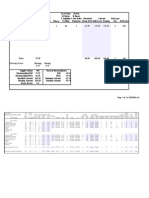Demand Factor-Diversity Factor-Utilization Factor-Load Factor - EEP
Demand Factor-Diversity Factor-Utilization Factor-Load Factor - EEP
Uploaded by
Mahesh MadasCopyright:
Available Formats
Demand Factor-Diversity Factor-Utilization Factor-Load Factor - EEP
Demand Factor-Diversity Factor-Utilization Factor-Load Factor - EEP
Uploaded by
Mahesh MadasOriginal Title
Copyright
Available Formats
Share this document
Did you find this document useful?
Is this content inappropriate?
Copyright:
Available Formats
Demand Factor-Diversity Factor-Utilization Factor-Load Factor - EEP
Demand Factor-Diversity Factor-Utilization Factor-Load Factor - EEP
Uploaded by
Mahesh MadasCopyright:
Available Formats
12/31/2014
DemandFactorDiversityFactorUtilizationFactorLoadFactor|EEP
Home Technical Articles Article Categories Contact us Subscribe to articles Subscribe to downloads El.
Enginering Guides
EE General guides
Power Substations
Schneider Electric CTs
Siemens Basics of EE
ABB Drives Guides
Industry Automation
Relay control/protection
Alternative Energy
Electrical Software MS Excel Spreadsheets Electrical Design Docs Engineering Resources
Video Lectures Electrical Engineering
PLC Programming Training
Electric Testing and Maintenance (VIDEO)
Network Theorems and Laws
-
DemandFactorDiversityFactorUtilization
FactorLoadFactor
Originally published at Electrical Notes Articles
(1)Demandfactor
Demand Factor = Maximum demand of a system / Total connected load on the system
Demand factor is always less than one.
Example: if a residence having 6000W equipment connected has a maximum demand of
300W,Than demand factor = 6000W / 3300W = 55%.
The lower the demand factor, the less system capacity required to serve the connected load.
Feeder-circuit conductors should have an ampere sufficient to carry the load the ampere of the
feeder-circuit need not always be equal to the total of all loads on all branch-circuits connected to
it.
Remember that the demand factor permits a feeder-circuit ampere to be less than 100% of the
sum of all branch-circuit loads connected to the feeder.
http://electricalengineeringportal.com/demandfactordiversityfactorutilizationfactorloadfactor
1/15
12/31/2014
DemandFactorDiversityFactorUtilizationFactorLoadFactor|EEP
Example: One Machine Shop has
Fluorescent fixtures=1 No, 5kw each, Receptacle outlets =1 No, 1500w each.
Lathe=1No, 10 Hp, Air Compressor=1 No, 20 Hp, Fire Pump=1 No, 15 Hp.
After questioning the customer about the various loads, the information is further deciphered as
follows:
1. The shop lights are on only during the hours of 8 a.m. to 5 p.m.
2. The receptacle outlets are in the office only, and will have computers and other small loads
plugged into them.
3. The lathe is fully loaded for 5 minutes periods. The rest of the time is setup time. This
procedure repeats every 15 minutes.
4. The air compressor supplies air to air tools and cycles off and on about half the time.
5. The fire pump only runs for 30 minutes when tested which is once a month after hours.
Calculation:
Lighting Demand Factor = Demand Interval Factor x Diversity Factor.
= (15 minute run time/ 15 minutes) x 1.0 = 1.0
Lighting Demand Load = 5 kW x 1.0 = 5 kW
Receptacle Outlet Demand Factor = Demand Interval Factor x Diversity Factor
= (15 minute run time / 15 minutes) x 0.1 = 0.1
Receptacle Outlet Demand Load = 15 x 1500 watts x 0.1 = 2.25 kW
Lathe Demand Factor = Demand Interval Factor x Diversity Factor.
= (5 minute run time / 15 minutes) x 1.0 =0 .33
Lathe Demand Load = 10 hp x .746 x .33 = 2.46 kW
Air Compressor Demand Factor = Demand Interval Factor x Diversity Factor.
= (7.5 minute run time / 15 minutes) x 1.0 = 0.5
Air Compressor Demand Load = 20 hp x .746 x .5 = 7.46 kW
Fire Pump Demand Factor = Demand Interval Factor x Diversity Factor.
= (15 minute run time/ 15 minutes) x 0.0 = 0.0
Fire Pump Demand Load = 15 hp x .746 x 0.0 = 0.0 kW
Summary of Demand Loads :
http://electricalengineeringportal.com/demandfactordiversityfactorutilizationfactorloadfactor
2/15
12/31/2014
DemandFactorDiversityFactorUtilizationFactorLoadFactor|EEP
Equipment
kW
D.F.
Demand KW
Lighting
Receptacle Outlets
22.5
.1
2.25
Lathe
7.5
.33
2.46
Air Compressor
15
0.5
7.46
Fire Pump
11.25
0.0
0.0
TOTAL
61.25 Kw
17.17 Kw
(2)Diversityfactor/simultaneityfactor(Ks)
Diversity Factor = Sum of Individual Max. Demand. / Max. Demand on Power Station.
Diversity Factor = Installed load. / Running load.
Diversity factor is usually more than one. (Since the sum of individual max. demands >Max. Demand)
The load is time dependent as well as being dependent upon equipment characteristics. The
diversity factor recognizes that the whole load does not equal the sum of its parts due to this
time Interdependence (i.e. diverseness).
When the maximum demand of a supply is being assessed it is not sufficient to simply add
together the ratings of all electrical equipment that could be connected to that supply. If this is
done, a figure somewhat higher than the true maximum demand will be produced. This is
because it is unlikely that all the electrical equipment on a supply will be used simultaneously.
The concept of being able to De-rate a potential maximum load to an actual maximum demand is
known as the application of a diversity factor.
70% diversity means that the device in question operates at its nominal or maximum load level
70% of the time that it is connected and turned on.
If total installed full load ampere is twice your running load ampere then the diversity factor is
two.
If total installed full load ampere is four times your load a ampere then the diversity factor is
four.
If everything (all electrical equipment) was running at full load at the same time the diversity
factor is equal to One
Greater the diversity factor, lesser is the cost of generation of power.
Diversity factor in a distribution network is the ratio of the sum of the peak demands of the
individual customers to the peak demand of the network.
This will be determined by the type of service, i.e., residential, commercial, industrial and
combinations of such.
Example-I: A distribution feeder serves 5 houses, each of which has a peak demand of 5 KW.
http://electricalengineeringportal.com/demandfactordiversityfactorutilizationfactorloadfactor
3/15
12/31/2014
DemandFactorDiversityFactorUtilizationFactorLoadFactor|EEP
The feeder peak turns out to be 20 kw. The diversity is then 20/25 or 0.8. This results from the
timing differences between the individual heating/cooling, appliance usages in the individual
customers.
As supply availability decreases, the diversity factor will tend to increase toward 1.00. This can be
demonstrated when restoring service after outages (called cold starts) as the system initial surge
can be much greater than the historical peak loads.
Example-II: A sub-station has three outgoing feeders:
1.
2.
3.
4.
feeder 1 has maximum demand 10 MW at 10:00 am,
feeder 2 has maximum demand 12 MW at 7:00 pm and
feeder 3 has maximum demand 15 MW at 9:00 pm,
While the maximum demand of all three feeders is 33 MW at 8:00 pm.
Here, the sum of the maximum demand of the individual sub-systems (feeders) is 10 + 12 + 15
= 37 MW, while the system maximum demand is 33 MW. The diversity factor is 37/33 = 1.12.
The diversity factor is usually greater than 1 its value also can be 1 which indicates the maximum
demand of the individual sub-system occurs simultaneously.
Diversity is the relationship between the rated full loads of the equipment downstream of a
connection point, and the rated load of the connection point. To illustrate:
1. The building at these co-ordinates is fitted with a 100A main supply fuse.
2. The distribution board has 2no. 6A breakers, 1no. 20A breaker and 5no. 32A breakers, a total,
potentially, of 192A.
Not all these rated loads are turned on at once. If they were, then the 100A supply fuse would
rupture, as it cannot pass 192A. So the diversity factor of the distribution board can be said to be
192A/100A, or 1.92, or 52%.
Many designers prefer to use unity as the diversity factor in calculations for planning
conservatism because of plant load growth uncertainties. Local experience can justify using a
diversity factor larger than unity, and smaller service entrance conductors and transformer
requirements chosen accordingly.
The diversity factor for all other installations will be different, and would be based upon a local
evaluation of the loads to be applied at different moments in time. Assuming it to be 1.0 may, on
some occasions, result in a supply feeder and equipment rating that is rather larger than the local
installation warrants, and an over-investment in cable and equipment to handle the rated load
current. It is better to evaluate the pattern of usage of the loads and calculate an acceptable
diversity factor for each particular case.
In the case of the example given above, achieving a diversity of 1.0 or 100% would require well
over twice the cross-sectional area of copper cable to be installed in a deep trench underneath a
field, the rebuild of a feeder cabinet to larger dimensions, more substantial overhead supply
cables for a distance exceeding 2km northwards and a different tariff, where one pays rather
more for a kWh than at present. The investment required to achieve 1.0 simply isnt justifiable in
http://electricalengineeringportal.com/demandfactordiversityfactorutilizationfactorloadfactor
4/15
12/31/2014
DemandFactorDiversityFactorUtilizationFactorLoadFactor|EEP
this particular case.
Diversity factor is mostly used for distribution feeder size and transformer as well as to
determine the maximum peak load and diversity factor is always based on knowing the process.
You have to understand what will be on or off at a given time for different buildings and this
will size the feeder. Note for typical buildings diversity factor is always one. You have to estimate
or have a data records to create 24 hours load graph and you can determine the maximum
demand load for node then you can easily determine the feeder and transformer size.
The diversity factor of a feeder would be the sum of the maximum demands of the individual
consumers divided by the maximum demand of the feeder. In the same manner, it is possible to
compute the diversity factor on a substation, a transmission line or a whole utility system.
The residential load has the highest diversity factor. Industrial loads have low diversity factors
usually of 1.4, street light practically unity and other loads vary between these limits.
DiversityFactorindistributionNetwork
Diversity Factors
Elements of System
Residential
Commercial
General
Power
Large
Industrial
Between individual users
2.00
1.46
1.45
Between transformers
1.30
1.30
1.35
1.05
Between feeders
1.15
1.15
1.15
1.05
Between substations
1.10
1.10
1.10
1.10
From users to transformers
2.00
1.46
1.44
From users to feeder
2.60
1.90
1.95
1.15
From users to substation
3.00
2.18
2.24
1.32
From users to generating station
3.29
2.40
2.46
1.45
DiversityFactorfordistributionswitchboards
http://electricalengineeringportal.com/demandfactordiversityfactorutilizationfactorloadfactor
5/15
12/31/2014
DemandFactorDiversityFactorUtilizationFactorLoadFactor|EEP
Number of circuits
Diversity Factor (ks)
Assemblies entirely tested 2 and 3
0.9
4 and 5
0.8
6 to 9
0.7
10 and more
0.6
Assemblies partially tested in every case choose
DiversityFactorforaccordingtocircuitfunction(IEC60439)
Circuits Function
Diversity Factor (ks)
Lighting
0.9
Heating and air conditioning
0.8
Socket-outlets
0.7
Lifts and catering hoist
For the most powerful motor
For the second most powerful motor
0.75
For all motors
0.8
DiversityFactorforanapartmentblock
http://electricalengineeringportal.com/demandfactordiversityfactorutilizationfactorloadfactor
6/15
12/31/2014
DemandFactorDiversityFactorUtilizationFactorLoadFactor|EEP
Apartment
Diversity Factor (ks)
2 To 4
5To 19
0.78
10To 14
0.63
15To 19
0.53
20To 24
0.49
25To 29
0.46
30 To 34
0.44
35 To 39
0.42
40To 40
0.41
50 To Above
0.40
Example: 5 storey apartment building with 25 consumers, each having 6 kVA of installed load.
The total installed load for the building is: 36 + 24 + 30 + 36 + 24 = 150 kVA
The apparent-power supply required for the building is: 150 x 0.46 = 69 kVA
It is a matter of common experience that the simultaneous operation of all installed loads of a
given installation never occurs in practice, i.e. there is always some degree of diversity and this
fact is taken into account for estimating purposes by the use of a simultaneity factor / Diversity
Factor (ks).
The Diversity factor ks is applied to each group of loads (e.g. being supplied from a distribution
or sub-distribution board). The determination of these factors is the responsibility of the designer,
since it requires a detailed knowledge of the installation and the conditions in which the
individual circuits are to be exploited. For this reason, it is not possible to give precise values for
general application.
Designing Size of Electrical Switchgear by use of Demand Factor and Diversity
Factor:
Diversity factors are used by utilities for distribution transformer sizing and load predictions.
Demand factors are more conservative and are used by NEC for service and feeder sizing.
Demand factors and diversity factors are used in design.
For example, the sum of the connected loads supplied by a feeder is multiplied by the demand
factor to determine the load for which the feeder must be sized. This load is termed the
maximum demand of the feeder. The sum of the maximum demand loads for a number of sub
feeders divided by the diversity factor for the sub feeders will give the maximum demand load to
be supplied by the feeder from which the sub feeders are derived.
http://electricalengineeringportal.com/demandfactordiversityfactorutilizationfactorloadfactor
7/15
12/31/2014
DemandFactorDiversityFactorUtilizationFactorLoadFactor|EEP
Example-1: Suppose We have four individual feeder-circuits with connected loads of 250 kVA,
200 kVA, 150 kVA and 400 kVA and demand factors of 90%, 80%, 75% and 85%
respectively.Use a diversity factor of 1.5.
Calculating demand for feeder-circuits
250 kVA x 90% = 225 kVA
200 kVA x 80% = 160 kVA
150 kVA x 75% = 112.5 kVA
400 kVA x 85% = 340 kVA
837.5 kVA
The sum of the individual demands is equal to 837.5 kVA.
If the main feeder-circuit were sized at unity diversity: kVA = 837.5 kVA 1.00 = 837.5
kVA.
The main feeder-circuit would have to be supplied by an 850 kVA transformer.
However, using the diversity factor of 1.5, the kVA = 837.5 kVA 1.5 = 558 kVA for the
main feeder.
For diversity factor of 1.5, a 600 kVA transformer could be used.
Example-2: A conveyor belt made up of six sections, each driven by a 2 kW motor. As
material is transported along this belt, it is first carried by section 1, and then each section
in succession until the final section is reached. In this simple example only one section of
conveyor is carrying material at any point in time. Therefore five motors are only handling
no-load mechanical losses (say .1 kW) keeping the belts moving whilst one motor is
handling the load (say 1 kW). The demand presented by each motor when it is carrying its
load is 1 kW, the sum of the demand loads is 6 kW but the maximum load presented by
the system at any time is only 1.5 kW.
Diversity factor =Sum of Individual Max. Demand / Max. Demand = 6 Kw / 1.5 Kw =4.
Demand Factor = Maximum demand / Total connected load = 1.5 Kw / 12 Kw = 0.125.
(3)Loadfactor
Load Factor = Average load. /Maximum load during a given period.
It can be calculated for a single day, for a month or for a year.
Its value is always less than one. Because maximum demand is always more than avg. demand.
It is used for determining the overall cost per unit generated. Higher the load factor, lesser will be the cost
per unit.
Load Factor = Load that a piece of equipment actually draws / Load it could draw (full load).
Example: Motor of 20 hp drives a constant 15 hp load whenever it is on.
The motor load factor is then 15/20 = 75%.
Load factor is term that does not appear on your utility bill, but does affect electricity costs.
Load factor indicates how efficiently the customer is using peak demand.
Load Factor = ( energy (kWh per month) ) / ( peak demand (kW) x hours/month )
http://electricalengineeringportal.com/demandfactordiversityfactorutilizationfactorloadfactor
8/15
12/31/2014
DemandFactorDiversityFactorUtilizationFactorLoadFactor|EEP
A high load factor means power usage is relatively constant. Low load factor shows that
occasionally a high demand is set. To service that peak, capacity is sitting idle for long periods,
thereby imposing higher costs on the system. Electrical rates are designed so that customers with
high load factor are charged less overall per kWh.
For Example
Customer A High Load Factor
82% load factor = (3000 kWh per month x 100%) / 5 kW x 730 hours/month.
Customer B Low Load Factor
41% load factor = (3000 kWh per month x 100%) / 10kW x 730 hours/month.
To encourage the efficient use of installed capacity, electricity rates are structured so the price per
kWh above a certain load factor is lower. The actual structure of the price blocks varies by rate.
(4)Utilizationfactor(Ku)
In normal operating conditions the power consumption of a load is sometimes less than that
indicated as its nominal power rating, a fairly common occurrence that justifies the application of
an utilization factor (ku) in the estimation of realistic values.
Utilization Factor = The time that a equipment is in use./ The total time that it could be
in use.
Example: The motor may only be used for eight hours a day, 50 weeks a year. The hours of
operation would then be 2000 hours, and the motor Utilization factor for a base of 8760 hours
per year would be 2000/8760 = 22.83%. With a base of 2000 hours per year, the motor
Utilization factor would be 100%. The bottom line is that the use factor is applied to get the
correct number of hours that the motor is in use.
This factor must be applied to each individual load, with particular attention to electric motors,
which are very rarely operated at full load. In an industrial installation this factor may be
estimated on an average at 0.75 for motors.
For incandescent-lighting loads, the factor always equals 1.
For socket-outlet circuits, the factors depend entirely on the type of appliances being supplied
from the sockets concerned.
Maximumdemand
Maximum demand (often referred to as MD) is the largest current normally carried by circuits,
switches and protective devices. It does not include the levels of current flowing under overload
or short circuit conditions.
Assessment of maximum demand is sometimes straightforward. For example, the maximum
demand of a 240 V single-phase 8 kW shower heater can be calculated by dividing the power (8
kW) by the voltage (240 V) to give a current of 33.3 A. This calculation assumes a power factor
of unity, which is a reasonable assumption for such a purely resistive load.
http://electricalengineeringportal.com/demandfactordiversityfactorutilizationfactorloadfactor
9/15
12/31/2014
DemandFactorDiversityFactorUtilizationFactorLoadFactor|EEP
There are times, however, when assessment of maximum demand is less obvious. For example, if
a ring circuit feeds fifteen 13 A sockets, the maximum demand clearly should not be 15 x 13 =
195 A, if only because the circuit protection will not be rated at more than 32 A. Some 13 A
sockets may feed table lamps with 60 W lamps fitted, whilst others may feed 3 kW washing
machines others again may not be loaded at all.
Lighting circuits pose a special problem when determining MD. Each lamp-holder must be
assumed to carry the current required by the connected load, subject to a minimum loading of
100 W per lamp holder (a demand of 0.42 A per lamp holder at 240 V). Discharge lamps are
particularly difficult to assess, and current cannot be calculated simply by dividing lamp power by
supply voltage. The reasons for this are:
1. Control gear losses result in additional current,
2. the power factor is usually less than unity so current is greater, and
3. Chokes and other control gear usually distort the waveform of the current so that it contains
harmonics which are additional to the fundamental supply current.
So long as the power factor of a discharge lighting circuit is not less than 0.85, the current
demand for the circuit can be calculated from:
current (A) = (lamp power (W) x 1.8) / supply voltage (V)
For example, the steady state current demand of a 240 V circuit supplying ten 65 W fluorescent
lamps would be: I = 10X65X1.8A / 240 = 4.88A
Switches for circuits feeding discharge lamps must be rated at twice the current they are required
to carry, unless they have been specially constructed to withstand the severe arcing resulting from
the switching of such inductive and capacitive loads.
(5)Coincidencefactor
The coincidence factor =Max. demand of a system / sum of the individual maximum
demands
The coincidence factor is the reciprocal of the diversity factor
DemandFactor&LoadFactoraccordingtoTypeofIndustries
Type of Industry
Demand
Factor
Load
Factor
Utilization
Factor (DF x
LF)
Arc Furnace
0.55
0.80
0.44
Induction Furnace
0.90
0.80
0.72
Steel Rolling mills
0.80
0.25
0.20
http://electricalengineeringportal.com/demandfactordiversityfactorutilizationfactorloadfactor
10/15
12/31/2014
DemandFactorDiversityFactorUtilizationFactorLoadFactor|EEP
Mechanical/ Electrical
a) Single Shift
0.45
0.25
0.11
b) Double Shift
0.45
0.50
0.22
Cycle Industry
0.40
0.40
0.16
Wire products
0.35
0.40
0.14
Auto Parts
0.40
0.50
0.20
Forgings
0.50
0.35
0.17
a) Working Season
0.60
0.65
0.39
b) Non-Working Season
0.25
0.15
0.04
0.70
0.80
0.56
b) Non-Working Season 0.05
0.30
0.01
Cold Storage
Rice Shellers
a) Working Season
Ice Candy Units
a) Working Season
0.50
0.65
0.32
b) Non-Working Season
0.50
0.10
0.05
a) Working Season
0.80
0.65
0.52
b) Non-Working Season
0.80
0.10
0.08
a) Working Season
0.70
0.25
0.17
b) Non-Working Season
0.10
0.10
0.01
Spinning Mills
0.60
0.80
0.48
Textile Industry
0.50
0.80
0.40
Dyeing and Printing
0.40
0.50
0.20
Ghee Mills
0.50
0.50
0.25
Oil Mills
0.70
0.50
0.35
Solvent Extraction Mills
0.45
0.50
0.22
Ice Factories
Cotton Ginning
http://electricalengineeringportal.com/demandfactordiversityfactorutilizationfactorloadfactor
11/15
12/31/2014
DemandFactorDiversityFactorUtilizationFactorLoadFactor|EEP
Plastic
0.60
0.25
0.11
Soap
0.50
0.25
0.12
Rubber (Foot Wear)
0.45
0.35
0.16
Distilleries
0.35
0.50
0.17
Chemical Industry
0.40
0.50
0.20
Gas Plant Industry
0.70
0.50
0.35
Pain and Colour Factory
0.50
0.40
0.20
Sugar
0.30
0.45
0.13
Paper
0.50
0.80
0.40
Flour Mills(Single Shift)
0.80
0.25
0.20
Atta Chakies
0.50
0.25
0.12
Milk Plants
0.40
0.80
0.32
Printing Presses
0.35
0.30
0.10
Repair Workshops
0.40
0.25
0.10
Bottling Plants
0.40
0.35
0.14
Radio Stations
0.55
.0.45
0.25
Telephone exchange
0.50
0.90
0.45
Public Water Works
0.75
0.40
0.30
Medical Colleges
0.60
0.25
0.15
Hospitals
0.25
0.90
0.22
Nursing Homes
0.50
0.50
0.25
Colleges and Schools
0.50
0.20
0.10
Hotels and Restaurants
0.75
0.40
0.30
Marriage Palaces
1.00
0.25
0.25
DemandFactor&LoadFactoraccordingtoTypeofBuildings:
Individual Facilities
Demand
Factor
Load Factor
http://electricalengineeringportal.com/demandfactordiversityfactorutilizationfactorloadfactor
12/15
12/31/2014
DemandFactorDiversityFactorUtilizationFactorLoadFactor|EEP
Communications buildings
60-65
70-75
Telephone exchange building
55-70
20-25
Air passenger terminal building
65-80
28-32
Aircraft fire and rescue station
25-35
13-17
Aircraft line operations building
65-80
24-28
Academic instruction building
40-60
22-26
Applied instruction building
35-65
24-28
Chemistry and Toxicology
Laboratory
70-80
22-28
Materials Laboratory
30-35
27-32
Physics Laboratory
70-80
22-28
Electrical and electronics systems
laboratory
20-30
3-7
Cold storage warehouse
70-75
20-25
General warehouse
75-80
23-28
Controlled humidity warehouse
60-65
33-38
Hazardous/flammable storehouse
75-80
20-25
Disposal, salvage, scrap building
35-40
25-20
Hospital
38-42
45-50
Laboratory
32-37
20-25
Dental Clinic
35-40
18-23
Medical Clinic
45-50
20-23
Administrative Office
50-65
20-35
Single-family residential housing
60-70
10-15
Detached garages
40-50
2-4
Apartments
35-40
38-42
Fire station
25-35
13-17
Police station
48-53
20-25
Bakery
30-35
45-60
http://electricalengineeringportal.com/demandfactordiversityfactorutilizationfactorloadfactor
13/15
12/31/2014
DemandFactorDiversityFactorUtilizationFactorLoadFactor|EEP
Laundry/dry cleaning plant
30-35
20-25
K-6 schools
75-80
10-15
7-12 schools
65-70
12-17
Churches
65-70
5-25
Post Office
75-80
20-25
Retail store
65-70
25-32
Bank
75-80
20-25
Supermarket
55-60
25-30
Restaurant
45-75
15-25
Auto repair shop
40-60
15-20
Hobby shop, art/crafts
30-40
25-30
Bowling alley
70-75
10-15
Gymnasium
70-75
20-45
Skating rink
70-75
10-15
Indoor swimming pool
55-60
25-50
Theater
45-55
8-13
Library
75-80
30-35
Golf clubhouse
75-80
15-20
Museum
75-80
30-35
RecommendedEEarticles
AboutAuthor//
Jignesh Parmar
jiguparmar - Jignesh Parmar has completed his B.E(Electrical) from Gujarat University. He is member
of Institution of Engineers (MIE),India. Membership No:M-1473586.He has more than 12 years
http://electricalengineeringportal.com/demandfactordiversityfactorutilizationfactorloadfactor
14/15
12/31/2014
DemandFactorDiversityFactorUtilizationFactorLoadFactor|EEP
experience in Transmission -Distribution-Electrical Energy theft detectionElectrical Maintenance-Electrical Projects (Planning-Designing-Technical
Review-coordination -Execution). He is Presently associate with one of the
leading business group as a Assistant Manager at Ahmedabad,India. He has
published numbers of Technical Articles in "Electrical Mirror", "Electrical
India", "Lighting India", "Industrial Electrix"(Australian Power Publications)
Magazines. He is Freelancer Programmer of Advance Excel and design useful
Excel base Electrical Programs as per IS, NEC, IEC,IEEE codes. He is
Technical Blogger and Familiar with English, Hindi, Gujarati, French
languages. He wants to Share his experience & Knowledge and help technical enthusiasts to find
suitable solutions and updating themselves on various Engineering Topics.
2014 EEP - Electrical Engineering Portal. All Rights Reserved | Privacy Policy | 34 queries in 0.266
seconds.
Powered by CsanyiGroup
SHARE
TOP
Get
PDF
http://electricalengineeringportal.com/demandfactordiversityfactorutilizationfactorloadfactor
15/15
You might also like
- Demand FactorDocument17 pagesDemand Factorkatiki216100% (1)
- Electrical Engineering Portal - Com Demand Factor Diversity Factor Utilization Factor Load FactorDocument12 pagesElectrical Engineering Portal - Com Demand Factor Diversity Factor Utilization Factor Load FactorBijay AgrawalNo ratings yet
- Demand Factor-Diversity Factor-Utilization Factor-Load FactorDocument13 pagesDemand Factor-Diversity Factor-Utilization Factor-Load FactorYousif_Abdalhalim100% (1)
- Bus BarDocument2 pagesBus BarwilmanzitoNo ratings yet
- Cable Size CalculationsDocument1 pageCable Size Calculationsjoydeep_d3232No ratings yet
- ELECTRICAL DESIGN InternDocument35 pagesELECTRICAL DESIGN Internomair sirajNo ratings yet
- Demand FactorDocument23 pagesDemand FactorVic Diaco100% (1)
- Short Circuit Current CalculationDocument3 pagesShort Circuit Current CalculationDHAMIM ANSARI0% (1)
- 2240 162 Pve U 004 SHT 3 3 01Document13 pages2240 162 Pve U 004 SHT 3 3 01Anagha DebNo ratings yet
- Fault Current CalculationDocument2 pagesFault Current CalculationApsi LalNo ratings yet
- E6 Electrical Service LoadDocument2 pagesE6 Electrical Service LoadKidesu RamadhaniNo ratings yet
- Cable Size CalculationsDocument4 pagesCable Size CalculationsgauravatiwariNo ratings yet
- Voltage Drop Calculation DraftDocument9 pagesVoltage Drop Calculation Draftmeeng2014No ratings yet
- Calculation of Short CircuitDocument1 pageCalculation of Short Circuitramkumartanwar100% (1)
- Electrical CalculationDocument1 pageElectrical Calculationengrwaqas_11100% (1)
- Generator Sizing CalculatorDocument4 pagesGenerator Sizing CalculatorNedunuri.Madhav Murthy100% (1)
- Diversity and Demand FactorDocument3 pagesDiversity and Demand FactorMuthuvel Ganesh100% (1)
- Sample Template - Distribution Panel Board ScheduleDocument1 pageSample Template - Distribution Panel Board Schedulemusleh19100% (4)
- Capacitor Bank Sizing CalculationDocument2 pagesCapacitor Bank Sizing CalculationArunava Basak50% (2)
- PROJECT STANDARDS AND SPECIFICATIONS Offshore Electrical Systems Rev01 PDFDocument12 pagesPROJECT STANDARDS AND SPECIFICATIONS Offshore Electrical Systems Rev01 PDFrrcardoso230No ratings yet
- Useful Electrical OperationsDocument53 pagesUseful Electrical Operationsthegemishere100% (2)
- How To Determine Correct Number of Earthing Electrodes (Strips, Plates and Pipes) - Part 1Document12 pagesHow To Determine Correct Number of Earthing Electrodes (Strips, Plates and Pipes) - Part 1Burraq Engineering SolutionsNo ratings yet
- Design of Insulator - 07.11.11Document1 pageDesign of Insulator - 07.11.11Natarajan RamakrishnanNo ratings yet
- Electrical Load ScheduleDocument55 pagesElectrical Load ScheduleLucky MalihanNo ratings yet
- 01 - Basic Electrical CalculationsDocument17 pages01 - Basic Electrical CalculationsRagesh JoshiNo ratings yet
- Diversity FactorDocument31 pagesDiversity FactorRamesh Ananthanarayanan0% (1)
- Lighting Lumen Calculation (10.6.13)Document12 pagesLighting Lumen Calculation (10.6.13)jiguparmar1516No ratings yet
- Transformer & DG SizingDocument10 pagesTransformer & DG Sizingvinaynagvanshi5100% (1)
- Selecting, Sizing Transformers For Commercial Buildings - Consulting-Specifying Engineer PDFDocument4 pagesSelecting, Sizing Transformers For Commercial Buildings - Consulting-Specifying Engineer PDFAshok Kumar Jena100% (1)
- Prc-El-00-003 Load List Calculation Procedure PDFDocument11 pagesPrc-El-00-003 Load List Calculation Procedure PDFsouheil boussaid100% (2)
- Coordination and Protection of Busbar DistributionDocument28 pagesCoordination and Protection of Busbar Distributionsaga2000cnNo ratings yet
- Electrical Design and DraftingDocument3 pagesElectrical Design and DraftingMURALINo ratings yet
- Earth Loop Impedance CalculationsDocument4 pagesEarth Loop Impedance Calculationsbstack10No ratings yet
- Electrical Thumb Rules - (Part 1)Document4 pagesElectrical Thumb Rules - (Part 1)rajdeep maity100% (2)
- Electrical Load ScheduleDocument14 pagesElectrical Load ScheduleAtty AttyNo ratings yet
- Solar Street LightsDocument5 pagesSolar Street LightsVidhyadar ThotaNo ratings yet
- Cable Sizing CalculationDocument28 pagesCable Sizing CalculationEmmanuel IfedioraNo ratings yet
- Electrical Load Distribution Schedule Revised 07-05-08Document84 pagesElectrical Load Distribution Schedule Revised 07-05-08JojolasNo ratings yet
- Cable Calculations CheckerDocument16 pagesCable Calculations Checkermelvyn9692100% (2)
- Voltage Drop CalculationsDocument6 pagesVoltage Drop Calculationsjasrock143100% (1)
- Trafo Sizing For DMDocument7 pagesTrafo Sizing For DMSonu DesaiNo ratings yet
- Transformer VA, MVA, KVA, Rating CalculationDocument2 pagesTransformer VA, MVA, KVA, Rating CalculationzaNo ratings yet
- Selective Coordination Breaker Application ChartDocument5 pagesSelective Coordination Breaker Application Charthanner90No ratings yet
- Calculate No of Lighting Fixtures Lumen For Indoor LightiNGDocument1 pageCalculate No of Lighting Fixtures Lumen For Indoor LightiNGmazen zaloudNo ratings yet
- Short Ckt. Calculation (LV) .Document2 pagesShort Ckt. Calculation (LV) .uddinnadeemNo ratings yet
- MNS-MCC LV SpecificationDocument16 pagesMNS-MCC LV SpecificationRaju MbkNo ratings yet
- Generator Sizing CalculationsDocument9 pagesGenerator Sizing Calculationshusnikhalil100% (2)
- Fault Current CalculationDocument11 pagesFault Current CalculationSaroj Kumar MallickNo ratings yet
- 3 Bus Bar Sizing CalculationDocument42 pages3 Bus Bar Sizing CalculationAnonymous OKkHA0NzNo ratings yet
- Load Schedule Format 1Document1 pageLoad Schedule Format 1Anonymous SrVaQYNo ratings yet
- N - Arc Consulting IrconDocument13 pagesN - Arc Consulting IrconPrashant TrivediNo ratings yet
- Battery SizingDocument41 pagesBattery Sizingअंकित अरोड़ा100% (1)
- Transformer DSDocument4 pagesTransformer DSjuliyet vNo ratings yet
- 3-Phase Short-Circuit Current (Isc) at Any Point Within A LV Installation - Electrical Installation GuideDocument5 pages3-Phase Short-Circuit Current (Isc) at Any Point Within A LV Installation - Electrical Installation Guidesiddiq shahNo ratings yet
- Attachment Cable Sizing CalculationDocument1 pageAttachment Cable Sizing CalculationnourfarmajidNo ratings yet
- Design and Assembly of APFC Electrical PanelDocument4 pagesDesign and Assembly of APFC Electrical PanelqxzyNo ratings yet
- Transformer KVA Sizing Calculation - Easy Version PDFDocument2 pagesTransformer KVA Sizing Calculation - Easy Version PDFmathan_ae100% (1)
- Demand Factor-Diversity Factor-Utilization Factor-Load FactorDocument18 pagesDemand Factor-Diversity Factor-Utilization Factor-Load FactorHimdad Tahir100% (2)
- Demand Factor-Diversity Factor-Utilization Factor-Load Factor - EEPDocument15 pagesDemand Factor-Diversity Factor-Utilization Factor-Load Factor - EEPaadieNo ratings yet
- Demand FactorDiversity FactorUtilization FactorLoad FactorDocument15 pagesDemand FactorDiversity FactorUtilization FactorLoad FactorscribistNo ratings yet
- How To Calculate Voltage Regulation of Distribution Line - EEPDocument8 pagesHow To Calculate Voltage Regulation of Distribution Line - EEPMahesh MadasNo ratings yet
- Cable Sizing Calculation - Open ElectricalDocument14 pagesCable Sizing Calculation - Open ElectricalMahesh MadasNo ratings yet
- Mobile Camps - Civil Site Assessments: DEP 34.17.10.34-GenDocument31 pagesMobile Camps - Civil Site Assessments: DEP 34.17.10.34-GenMahesh MadasNo ratings yet
- Riyadh Cbales - LVDocument6 pagesRiyadh Cbales - LVMahesh MadasNo ratings yet
- Ministry of Foreign Affairs Singapore Cooperation Programme: Singcon - Maa@mfa - SGDocument2 pagesMinistry of Foreign Affairs Singapore Cooperation Programme: Singcon - Maa@mfa - SGMahesh MadasNo ratings yet
- Flow Master Easy GuideDocument4 pagesFlow Master Easy GuideMahesh MadasNo ratings yet
- PAN CR Dos and Don'TsDocument2 pagesPAN CR Dos and Don'TsMahesh MadasNo ratings yet
- AFIL AMITANK final-WS HIDD PDFDocument12 pagesAFIL AMITANK final-WS HIDD PDFMahesh MadasNo ratings yet
- Motor ClasstyDocument128 pagesMotor Classtywatep_08No ratings yet
- 37 Things To Do in Salalah, OmanDocument15 pages37 Things To Do in Salalah, OmanMahesh MadasNo ratings yet
- You May Need A Visa To Enter Schengen - AXA SchengenDocument2 pagesYou May Need A Visa To Enter Schengen - AXA SchengenMahesh MadasNo ratings yet
- CP1 2 Draft 1 v7 (Public Comment)Document220 pagesCP1 2 Draft 1 v7 (Public Comment)Martin BrookesNo ratings yet
- Ansul Foam PourerDocument2 pagesAnsul Foam PourerAnonymous rKzIfkK9No ratings yet
- Appraising The Smart Card Technology Adoption Case of Application in University EnvironmentDocument9 pagesAppraising The Smart Card Technology Adoption Case of Application in University EnvironmentHamed TaherdoostNo ratings yet
- Clean LogDocument2 pagesClean LogJasher DariaganNo ratings yet
- Eventide Eclipse: User ManualDocument66 pagesEventide Eclipse: User ManualRob NewellNo ratings yet
- Caws PDFDocument163 pagesCaws PDFSlick720% (1)
- Competency Based Interviews Q&ADocument14 pagesCompetency Based Interviews Q&Ataap100% (1)
- Die Set Engineering Handbook and CatalogDocument144 pagesDie Set Engineering Handbook and CatalogEduardo Medel50% (2)
- Ed 7202 QP Ut 2Document5 pagesEd 7202 QP Ut 2pandirajaNo ratings yet
- Livia Catalogue PDFDocument7 pagesLivia Catalogue PDFJessa AnnaNo ratings yet
- GenspaDocument373 pagesGenspaJulian Andres Zancajo100% (1)
- Terminologies and UnitsDocument27 pagesTerminologies and UnitsTrần Châu ThôngNo ratings yet
- 674-Article Text-2894-1-10-20230411Document12 pages674-Article Text-2894-1-10-20230411Vini MegaNo ratings yet
- 74AC374, 74ACT374 Octal D-Type Flip-Flop With 3-STATE OutputsDocument15 pages74AC374, 74ACT374 Octal D-Type Flip-Flop With 3-STATE OutputsshohratNo ratings yet
- Generator TroubleshootingDocument22 pagesGenerator TroubleshootingMichael Cabrera Rabino100% (2)
- Experimental Study of Performance Characteristics of Turbine Meter in Oil Medium, by Onwunyili Christian ChimeDocument73 pagesExperimental Study of Performance Characteristics of Turbine Meter in Oil Medium, by Onwunyili Christian Chimecoskwejie100% (1)
- 2019 Aon Global Risk Management Survey ReportDocument120 pages2019 Aon Global Risk Management Survey ReportLottera SilvaNo ratings yet
- 757-4002-383 Nexcom715Document10 pages757-4002-383 Nexcom715Admir Talic100% (1)
- Adoncourse RegnsylbDocument233 pagesAdoncourse RegnsylbValli MuthuNo ratings yet
- Excitation System PDFDocument32 pagesExcitation System PDFmaneesh_03100% (1)
- Not Just Another Boring Graphic Standards ManualDocument20 pagesNot Just Another Boring Graphic Standards ManualMax BurgerNo ratings yet
- KepserverEx v5 Manual PDFDocument187 pagesKepserverEx v5 Manual PDFdatlogNo ratings yet
- IGNOU - WWW - Ignou.ac - in Indira Gandhi National Open UniversityDocument3 pagesIGNOU - WWW - Ignou.ac - in Indira Gandhi National Open UniversityruchipankajNo ratings yet
- Droplet Evaporation With Reference To The Effectiveness of Water Mist CoolingDocument9 pagesDroplet Evaporation With Reference To The Effectiveness of Water Mist CoolingWhidas PrihantoroNo ratings yet
- 2016-17 DBF RulesDocument34 pages2016-17 DBF RulesCristian LealNo ratings yet
- NLP 2012 BrochureDocument2 pagesNLP 2012 BrochureViseshNo ratings yet
- Final Dis..Document39 pagesFinal Dis..Mubasher YousufNo ratings yet
- TEMPLATE - Research - Project - Xhunejda and SarandaDocument6 pagesTEMPLATE - Research - Project - Xhunejda and SarandaSaranda YmeriNo ratings yet
- Prepare An App For Conversion With The Desktop Bridge: Windows Dev CenterDocument7 pagesPrepare An App For Conversion With The Desktop Bridge: Windows Dev CenterAlejandro Mtz RamosNo ratings yet
- STS Intro, Science and Technology Excerpt FR Roger PosadasDocument5 pagesSTS Intro, Science and Technology Excerpt FR Roger PosadasCarlo CondeNo ratings yet




































































































